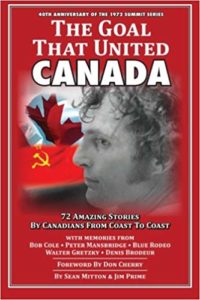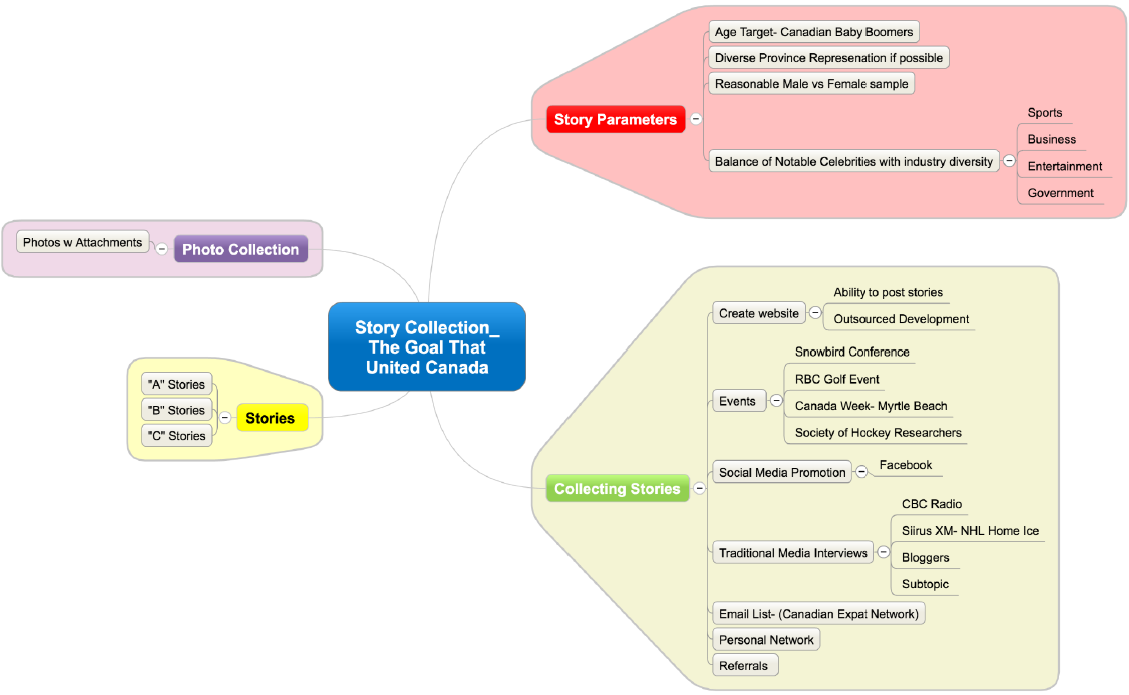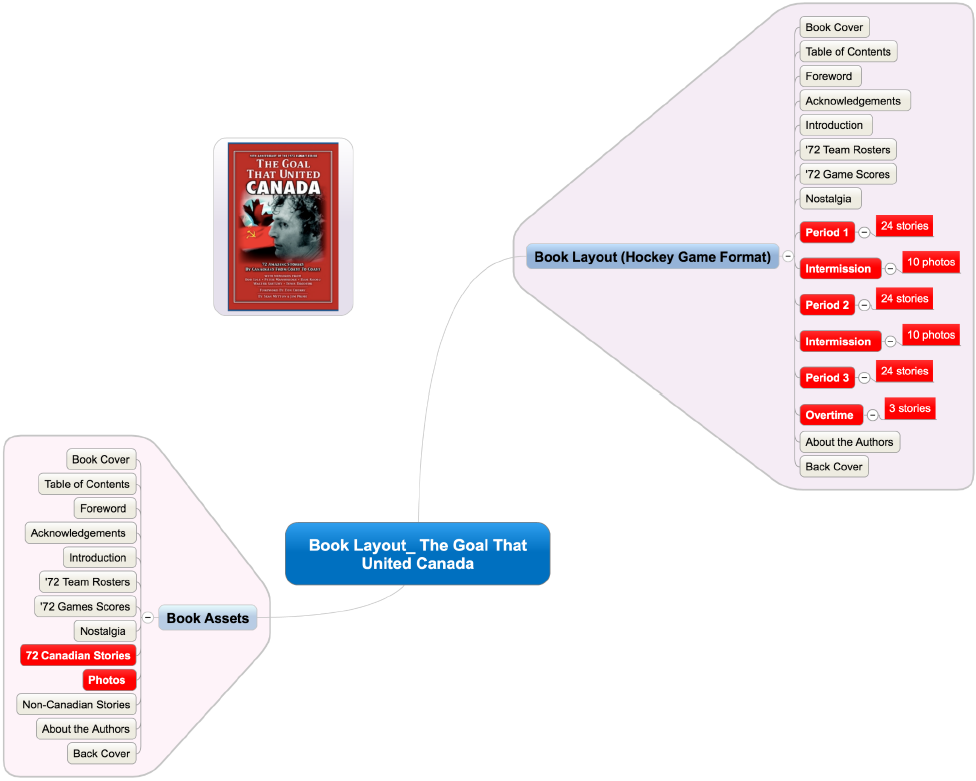This is the fourth post in the series How to write a book using mind maps. These posts feature the story of how Sean Mitton accomplished his ambitious goal of writing his first book, The Goal That United Canada.
You can find his other posts here:
- How to write a book using mind maps: Part 1
- How to write a book using mind maps: Part 2 – The strategy
- How to write a book using mind maps: Part 3 – Project management
- How to write a book using mind maps: Part 5 – Media interviews and presentations
Guest Blogger: Sean Mitton
Let me pose a question. You have about 10 months to collect 200 stories from Canadian Baby Boomers about where they were and what in meant to them when Paul Henderson scored his winning goal against the Russians in 1972. And, you have to turn those story ideas into the layout and content for a book.
How would you approach it?

Before I tell you how I mind mapped a series of ideas to solve this problem, I will say that I had two considerations regarding the collection of stories.
- Firstly, how many people would remember something that happened almost 40 years ago?
- And secondly, what if all the stories sounded the same?
The good news is that I found 70% of the people I asked had clear recollections of that fateful game, and there was a better diversity of stories then I could ever have expected.
But to get to that point, I needed to map out the story parameters, how I would gather the interviews, and how I would structure then into a book. This post will look at that process, and how MindManager fit into the picture.
Mapping out the story parameters
Before I mapped out the strategy for collecting the interviews, I wanted to create a few parameters and targets for collecting a broad range of stories. These included:
- Finding Canadian Baby Boomers (alive in 1972).
- Getting representation from each province in Canada (of which there are 10, and two territories).
- Finding a reasonable balance between male and female, if possible.
- Connecting with a mix of notable Canadian celebrities in different fields such as sports, entertainment, media, politics, and so on.
I particularly liked the idea of the hearing stories of notable Canadians from before they became popular or well known. Some examples included Peter Mansbridge (famous CBC news broadcaster), the members of Blue Rodeo (rock band in Canada), and Glenn Howard (Olympic curler). In some cases, events like the ’72 Summit series helped shape their views of the country and their future careers.
One of the things I like so much about mind mapping is that the process helps in asking better questions, and in drawing connections between answers. This leads to not only better interviews, but a better interpretation of them as well. MindManager makes it easy to gather interview ideas and questions quickly, making the overall process of collecting 200 interviews much more efficient.
Collecting the stories
After mapping out my requirements, I realized that the approach I would take to connecting with interviewees and gathering their stories would need to be diversified, because I didn’t know which strategy would yield the best results.
Some of the platforms I used to connect with interviewees included:
- My website;
- Events (i.e. a Snowbird conference);
- Social media;
- Interviews through the media;
- Email lists; and
- My personal network
Below you will see a screenshot of the map I used to gather these ideas, and expand on different opportunities for each platform.
As I collected and reviewed these stories, I grouped them into three categories:
- Category A = Book worthy
- Category B = Possible selection
- Category C = Missed the cut
The stories that I believed were book worthy would be edited again later for publishing. The nice thing is that as I went through this process, I could regularly see how many more stories I would need to gather to get to my goal of 72. This approach worked very well and, in the process of collecting stories, I also received several extras that I could use in the book, including ticket stubs, posters, pucks, and game photos.
To manage all of this story text and images, I used the mind map sub-topics to link to various websites, Word documents, and so on to help manager the abundance of content.
After finishing this phase of the project (and looking back at my mind map), I realized that I had collected a high percentage of stories through events, networking and referrals. Good to know for next time!
Using mind maps to brainstorm the book experience
Throughout this process, the reader experience was always at the back of my mind. Mind mapping was a perfect way to keep all of my book assets closely at hand, allowing me to continually think about how I wanted to organize the material. “How can I create a better reader experience?” was my mantra.
When you read a book, do you think about the experience? Does it engage you? If so, how was it structured to accomplish that engagement? These are the questions I asked myself.
To achieve this goal, I concluded that these sections would need to be included in the book to create a great reader experience:
- Table of Contents
- Foreword
- Introduction
- Acknowledgements
- ‘72 team members
- Game and scoring results
- Nostalgia
- 72 Canadian stories
- Photos
- Additional non-Canadian stories
- About the authors
Once idea that struck me as I was examined the content in my mind map was to create the book layout like a hockey game. That is: three periods (and overtime), with intermissions in between.
The stories would be divided into three periods, with the photos representing the two intermissions. Three other stories that I really liked would fall into the “overtime” category. Those included a story from a U.S. official, a Russian barber and the story of where Paul Henderson was when Sidney Crosby scored his own gold medal winning, overtime goal for Canada during the Vancouver 2010 Olympics (another moment of immense national pride of the country).
Here’s a screenshot of the mind map I used to plan the book experience.
As a side note, I didn’t have enough time to seek a publisher, so I decided to go the route of self publishing. I mind mapped the pros and cons of the different options, and selected Lulu who was conveniently located in Raleigh, North Carolina, where I reside.
In the next (and final) post, I’ll share how MindManager helped me prepare for and improve my memory recall for the Media Tour and Speaker’s Panel at the Hockey Hall of Fame in Toronto.
Thanks for reading!
About Sean Mitton
In the past 15 years, Sean Mitton has created over 700 mind maps as an Entrepreneur, Author, Speaker, Reporter, Web designer and Coach. He Founded the Canadian Expat Network, co-authored the book “The Goal That United Canada”, has been interviewed by over 30 media outlets and has interviewed notable athletes, entertainers, politicians and business leaders. He’s spoken at universities, community college conference, libraries and the Hockey Hall of Fame. In 2010, he organized the first Terry Fox Run for Cancer Research in North Carolina. Every step of the way, he’s created mind maps to keep organized, be more creative, strategic and simplify ideas. Throughout this process, he has found that by asking better questions through mind mapping, you can achieve better results!



